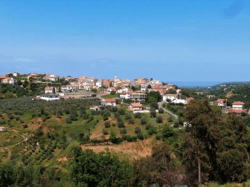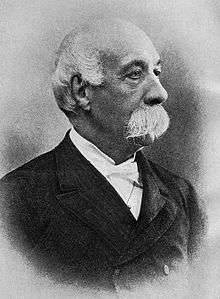Albanians in Italy
The Albanians in Italy (Italian: Albanesi in Italia; Albanian: Shqiptarët në Itali) refers to the Albanian migrants in Italy and their descendants. They mostly trace their origins to Albania, Greece and since recently to a lesser extent to Kosovo[lower-alpha 1], North Macedonia and other Albanian-speaking territories in the Balkan Peninsula. They are adherents of different religions and are Catholics, Orthodox, Protestants, Sunnis and Bektashis as well as various forms of Irreligion.
| Total population | |
|---|---|
| Regions with significant populations | |
| Languages | |
| Religion | |
| Related ethnic groups | |
| Albanians in Greece |
| Part of a series on |
| Albanians |
|---|
 |
| By country |
|
Native Albania · Kosovo Croatia · Greece · Italy · Montenegro · North Macedonia · Serbia Diaspora Australia · Bulgaria · Denmark · Egypt · Finland · Germany · Norway · Romania · South America · Spain · Sweden · Switzerland · Turkey · Ukraine · United Kingdom · United States |
| Culture |
| Architecture · Art · Cuisine · Dance · Dress · Literature · Music · Mythology · Politics · Religion · Symbols · Traditions · Fis |
| Religion |
| Christianity (Catholicism · Orthodoxy · Protestantism) · Islam (Sunnism · Bektashism) · Judaism |
| Languages and dialects |
|
Albanian Gheg (Arbanasi · Upper Reka dialect · Istrian) · Tosk (Arbëresh · Arvanitika · Calabria Arbëresh · Cham · Lab) |
| History of Albania |
The Albanians in Italy may include among others a long established Arbëreshë population in Apulia, Basilicata, Calabria, Sicily and across Southern Italy as well as Albanians to have migrated to Italy from any territory with an Albanian population in the Balkans and any person originally from the Republic of Albania.
There is an Albanian community in southern Italy, known as Arbëreshë, who had settled in the country starting with the 15th and the 16th century and later, displaced by the changes brought about by the expansion of the Ottoman Empire. Some managed to escape and were offered refuge from the repression by the Kingdom of Naples and Kingdom of Sicily (both under Aragonese rule), where the Arbëreshë were given their own villages and protected.[2] The Arbëreshë were estimated as numbering at a quarter million in the year 1976.[3]
History
Medieval period

The Italian Peninsula across the Adriatic Sea has attracted the Albanian people in the Balkan Peninsula for more than half a millennium often due to the immediate proximity which was also seen as the primary gateway to Western Europe. The medieval ancestors of the Arbëreshë people were the first Albanian people to migrate to Italy historically as mercenaries in the services for the kingdoms of the Neapolitans, Sicilians and Venetians.[4][5]
During the 14th and 16th centuries AD, groups of Albanians started to settle in the Italian Peninsula. Their migration stemmed from severe political and social oppression and islamization process of the Ottomans following the Ottoman conquest of the Balkans.
Modern period
As a consequence after the collapse of communism in Albania in 1990, Italy had been the main migration target for the Albanian people leaving their country. This exodus was fueled mainly by social and economic instability, a looming fear of civil war and lack of confidence in the democratization process of Albania.
Around 3 weeks after the overturning of the regime, in March 1991, around 25,700 Albanians crossed the Strait of Otranto into Italy.[6] Subsequently, in August 1991, another 20,000 migrants arrived in Bari Harbour aboard the Vlora.[7] The Italian government classified such Albanians as “illegal economic migrants” and started repatriated them after a period of detention in special camps in Southern Italy. Albanian attempts to immigrate by sea caused the Italian government to deploy a considerable number of Italian soldiers along the coast of Puglia - directly facing Albania.[8]
Italy had been a symbol of the West for many Albanians during the communist period, because of its geographic proximity. Additionally, Albania past status as an Italian colony might have fueled immigration efforts into Italy specifically.[9] There is also a linguistic connection similar to what attracts Romanians to Italy, as the Albanian language, although not itself Romance, has a huge amount of vocabulary of Romance origin like English or Maltese. Italy reacted to this migration pressure by introducing the "Martelli" law, stipulating that any immigrant who could prove that he or she had come into the country before the end of 1989 be granted a two-year residency permit.
The perception of Albanian immigrants by Italian citizens in the period was overwhelmingly negative. Italian media in the 1990s played a large part in devaluing and inferiorizing the Albanian immigrants.[10] A quantitative analysis of the frequency of words occurring in news articles within the early 1990s revealed that articles mentioning Albanians were positively correlated with the occurrence of words conveying negative sentiment. Therefore, articles mentioning Albanians were more likely to have news about organized crime and other activities with an illicit connotation.[11] There were also instances where newspapers propagated misinformation: such as linking the cholera outbursts in Bari with the inflow of refugees from Albania.[12]
From March 1997, Italy instituted a strict patrol of the Adriatic in an attempt to curb Albanian immigration. As a result, many Albanian immigrants in Italy do not have a legal status. Out of an estimated 150,000 Albanian immigrants in Italy in 1998, only some 82,000 were registered with authorities. In total there are 800,000 Albanians in Italy.[13] Italy also took efforts to alleviate the plight of Albanians in Albania. As a response to the Albanian political and refugee crisis in April 1997, in association with the United Nations, Italy led Operation Alba. This was a military-humanitarian mission involving 6000 Italian personnel. It was undertaken in order to deliver aid to the Albanian people.[14]
The Italian Government has housed significant numbers of Albanians from Kosovo in the Arbëresh settlements, most notably in Piana degli Albanesi in Sicily.
Demographics
Population

The regions with the most significant concentration of the modern Albanian population are Emilia-Romagna, Friuli Venezia Giulia, Lombardy, Tuscany, Piedmont and Veneto predominantly in the northeastern, northwestern and central region of Italy. The most lesser number are to be found in Aosta Valley, Basilicata, Molise and Sardinia. Though in contrast, the medieval Albanian population is geographically distributed in Basilicata, Calabria and Sicily mostly in southern region of Italy.[15]
The Albanian population of Italy, only the Albanians with Albanian nationality, has noted a steady increase in the recent years especially during the fall of communism in the 1990s and the beginnings of the 21st century.[16][17][18] It has doubled between 2003 and 2009 from 216,582 to 441,396 constituting a total increase of 103,8%.[1] During the period between from 2014 to 2018, the population decreased by approximately 11% from 482,627 to 440 465.[1]
The distribution of Albanians in Italy as of 2019:[19]
| Region | ||
|---|---|---|
| 735 | 5 | |
| 11,830 | 1,612 | |
| 22,733 | 185 | |
| 1,956 | 13 | |
| 2,940 | 62 | |
| 7,064 | 136 | |
| 57,969 | 2,470 | |
| 9,588 | 3,519 | |
| 24,454 | 1,827 | |
| 21,866 | 393 | |
| 92,332 | 8,400 | |
| 15,863 | 917 | |
| 807 | 173 | |
| 40,919 | 622 | |
| 682 | 37 | |
| 9,062 | 79 | |
| 62,066 | 5,608 | |
| 11,310 | 3,273 | |
| 13,093 | 644 | |
| 33,758 | 10,533 | |
| 441,027 | 40,508 | |
Religion
The Albanian people and so the Albanian people of Italy traditionally adhere to different religious faiths and beliefs. They are traditionally both Christians and Muslims, Catholics and Orthodox, Bektashis and Sunnis but also to a lesser extant Evangelists, Protestants, Jews or non-religious, perhaps constituting the most religiously diverse people of Europe.[20]
In the years 2011 and 2012 the ISTAT made a survey regarding the religious affiliation among the immigrants in Italy, the religion of the Albanian people in Italy were as follows:[21]
- Muslims: 41.5%
- Christians: 38.7%
- Non religious. 17.8%
- Other religions: 1.7%
Notable people
Selected people:
See also
- Immigration to Italy
- Albanian diaspora
- Albanians in Greece
- Arbëreshë people and settlements
Notes
- Kosovo is the subject of a territorial dispute between the Republic of Kosovo and the Republic of Serbia. The Republic of Kosovo unilaterally declared independence on 17 February 2008, but Serbia continues to claim it as part of its own sovereign territory. The two governments began to normalise relations in 2013, as part of the 2013 Brussels Agreement. Kosovo is currently recognized as an independent state by 97 out of the 193 United Nations member states. In total, 112 UN member states recognized Kosovo at some point, of which 15 later withdrew their recognition.
References
- "Resident foreigners on 1st January - Citizenship 2003–2019". istat.it. Istituto Nazionale Di Statistica.
- "LE MIGRAZIONI DEGLI ARBERESHE".
- Albanian, Arbëreshë - A language of Italy - Ethnic population: 260,000 (Stephens 1976).
- Giornale enciclopedico di Napoli (in Italian). Orsiniana. 1807. p. 152.
- "Gli arbëreshë e la Basilicata". distoriadistorie.blogspot.it (in Italian).
- R.D., Grillo; Jeff., Pratt (January 2002). The politics of recognizing difference : multiculturalism Italian-style. Ashgate, Ashgate. ISBN 9780754618911. OCLC 799289730.
- Campani, Giovanna. "Albanian Refugees in Italy". Refuge: Canada’s Journal on Refugees. Retrieved 24 April 2017.
- R.D., Grillo; Jeff., Pratt (January 2002). The politics of recognizing difference : multiculturalism Italian-style. Ashgate, Ashgate. ISBN 9780754618911. OCLC 799289730.
- R.D., Grillo; Jeff., Pratt (January 2002). The politics of recognizing difference : multiculturalism Italian-style. Ashgate, Ashgate. ISBN 9780754618911. OCLC 799289730.
- R.D., Grillo; Jeff., Pratt (January 2002). The politics of recognizing difference : multiculturalism Italian-style. Ashgate, Ashgate. ISBN 9780754618911. OCLC 799289730.
- Stoppiello, S. (1999), “Nomi e immagini dell' ‘altro’. Un’analisi multidimensionale della stampa”, Studie emigrazione, 36 (135), pp. 417-442.
- R.D., Grillo; Jeff., Pratt (January 2002). The politics of recognizing difference : multiculturalism Italian-style. Ashgate, Ashgate. ISBN 9780754618911. OCLC 799289730.
- "Albania: Looking Beyond Borders". migrationpolicy.org. 2004-08-01. Retrieved 2017-04-25.
- R.D., Grillo; Jeff., Pratt (January 2002). The politics of recognizing difference : multiculturalism Italian-style. Ashgate, Ashgate. ISBN 9780754618911. OCLC 799289730.
- Minni, C. Dino; Ciampolini, Anna Foschi (1990). Writers in transition: the proceedings of the First National Conference of Italian-Canadian Writers. Guernica Editions. pp. 63–4. ISBN 978-0-920717-26-4. Retrieved 30 September 2010.
- Clarissa De Waal (2005-06-24). Albania: Portrait of a Country in Transition. I.B.Tauris, 2005. pp. 5–7. ISBN 9780857710239.
- Giovama Campani. "Albanian Refugees in Italy" (PDF). refuge.journals.yorku.ca. pp. 1–4.
- "The Integration of Albanian Immigrants in Greece. A comparative approach in three specific regions: Thessaloniki, Chalkidiki and Crete". digitalarchive.maastrichtuniversity.nl. pp. 7–12. Archived from the original (PDF) on 10 November 2018. Retrieved 10 November 2018.
- "Resident foreigners on 1st January - Citizenship". istat.it. Istituto Nazionale Di Statistica.
- Bogdani, Mirela; Loughlin, John (2007). Albania and the European Union: The Tumultuous Journey Towards Integration and Accession. I.B.Tauris. p. 34. ISBN 978-1-84511-308-7. Retrieved 16 April 2017.
- "Appartenenza e pratica religiosa tra i cittadini stranieri". www.istat.it (in Italian). 2014-10-30. Retrieved 2017-10-22.






